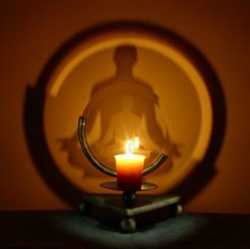Difference between revisions of "Esoteric Buddhist Bodhisattva"
(Created page with " Esoteric Buddhism (mikkyô) originated in {{Wiki|northern India}} and Tibet. Immigrants from China transmitted an incomplete form of this teaching t...") |
|||
| Line 1: | Line 1: | ||
| + | <nomobile>{{DisplayImages|1544|3575}}</nomobile> | ||
| − | + | <poem> | |
| − | |||
[[Esoteric Buddhism]] ([[mikkyô]]) originated in {{Wiki|northern India}} and [[Tibet]]. Immigrants from [[China]] transmitted an incomplete [[form]] of this [[teaching]] to [[Japan]] in the eighth century. | [[Esoteric Buddhism]] ([[mikkyô]]) originated in {{Wiki|northern India}} and [[Tibet]]. Immigrants from [[China]] transmitted an incomplete [[form]] of this [[teaching]] to [[Japan]] in the eighth century. | ||
| − | [[Japanese | + | [[Japanese monks]] traveling in [[China]] in the ninth century acquired complete [[knowledge]] of this [[highly complex form of Buddhism]]. |
They returned to [[Japan]] with large [[mandalas]] that chart the relationship between various [[deities]] in a highly systematic and hierarchical fashion. | They returned to [[Japan]] with large [[mandalas]] that chart the relationship between various [[deities]] in a highly systematic and hierarchical fashion. | ||
| Line 10: | Line 10: | ||
A small number of these [[deities]] eventually gained widespread [[popularity]] in [[Japan]], and {{Wiki|artists}} often depicted them as {{Wiki|individual}} icons, as in this painting. | A small number of these [[deities]] eventually gained widespread [[popularity]] in [[Japan]], and {{Wiki|artists}} often depicted them as {{Wiki|individual}} icons, as in this painting. | ||
| − | The complexity of the [[esoteric | + | The complexity of the [[esoteric pantheon]] compelled painters to focus primarily on iconographic details such as the {{Wiki|crown}}, the jewelry, and the implements this [[deity]] holds in its many hands. |
Careful replication of these accoutrements was necessary in order to identify the [[deity]]. | Careful replication of these accoutrements was necessary in order to identify the [[deity]]. | ||
| Line 18: | Line 18: | ||
[[Bodhisattvas]] were [[divine]] begins who postponed their [[enlightenment]] in order to help all [[sentient]] [[life]] fulfill its [[spiritual]] quest. | [[Bodhisattvas]] were [[divine]] begins who postponed their [[enlightenment]] in order to help all [[sentient]] [[life]] fulfill its [[spiritual]] quest. | ||
| − | [[Kannon]] were regarded as the most [[compassionate]] of the [[bodhisattvas]]. Precisely which [[manifestation]] of [[Kannon]] is depicted in this work is difficult to ascertain with {{Wiki|certainty}}, however. [[Esoteric]] [[mandalas]] often include as many as twenty or more different [[forms]] of [[Kannon]]. | + | [[Kannon]] were regarded as the most [[compassionate]] of the [[bodhisattvas]]. |
| + | |||
| + | Precisely which [[manifestation]] of [[Kannon]] is depicted in this work is difficult to ascertain with {{Wiki|certainty}}, however. | ||
| + | |||
| + | [[Esoteric]] [[mandalas]] often include as many as twenty or more different [[forms]] of [[Kannon]]. | ||
[[Doctrinal]] sources include many more. | [[Doctrinal]] sources include many more. | ||
| Line 36: | Line 40: | ||
Seeking the [[vow]] within the [[heart]] | Seeking the [[vow]] within the [[heart]] | ||
All [[repose]] in the mansion | All [[repose]] in the mansion | ||
| + | </poem> | ||
| + | {{R}} | ||
| + | http://www.dartmouth.edu/~arth17/Esoteric.html | ||
| + | [[Category:Bodhisattva's]] | ||
Revision as of 09:55, 3 November 2015
Esoteric Buddhism (mikkyô) originated in northern India and Tibet. Immigrants from China transmitted an incomplete form of this teaching to Japan in the eighth century.
Japanese monks traveling in China in the ninth century acquired complete knowledge of this highly complex form of Buddhism.
They returned to Japan with large mandalas that chart the relationship between various deities in a highly systematic and hierarchical fashion.
A small number of these deities eventually gained widespread popularity in Japan, and artists often depicted them as individual icons, as in this painting.
The complexity of the esoteric pantheon compelled painters to focus primarily on iconographic details such as the crown, the jewelry, and the implements this deity holds in its many hands.
Careful replication of these accoutrements was necessary in order to identify the deity.
The small Buddha in the crown of the deity suggests that it is a manifestation of Kannon Bodhisattva.
Bodhisattvas were divine begins who postponed their enlightenment in order to help all sentient life fulfill its spiritual quest.
Kannon were regarded as the most compassionate of the bodhisattvas.
Precisely which manifestation of Kannon is depicted in this work is difficult to ascertain with certainty, however.
Esoteric mandalas often include as many as twenty or more different forms of Kannon.
Doctrinal sources include many more.
In general, icon paintings were heavily ornamented. It was one way of highlighting the efficacy of the image.
The highly decorative qualities of the work, including the application of cut gold leaf, were an integral part of this enterprise.
The artist's personal expression was muted but not entirely absent.
The inscription suggests how this painting might have been used.
Meditating on this great Bright King
One quickly attains the proper path
Completely masters the law
And extinguishes misdeeds
Seeking the vow within the heart
All repose in the mansion

